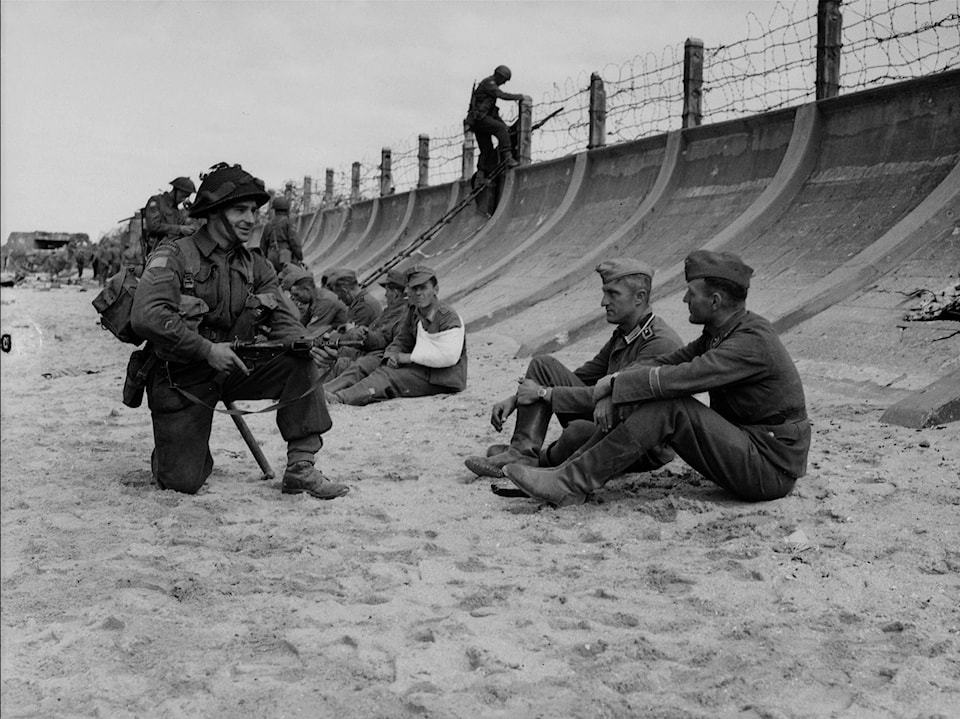After British and American bombers struck the beaches of Normandy “with a roar that drowned out naval gunfire,” it was the Canadians’ turn to smash through the German defence line with waves of landing foot soldiers.
Canadian Press war correspondent Ross Munro described this “mightiest spectacle” that he witnessed on June 6, 1944, at Juno Beach, writing: “I have never beheld anything so tremendous” as the opening of the Western Front by Allied forces.
“Under cover of this colossal barrage” of British and American bombers, Munro wrote, “Canadian infantry and engineers in the first assault waves plunged through the white-capped waves in their small landing craft.”
As the first regiment touched down on the beach, other units followed in rapid succession, some coming under heavy machine-gun fire and shelling, “but they fought their way forward and gained the first objectives on scheduled time.”
At 10:45 a.m., the Canadian commander sent a message to the lieutenant-general: “Beachhead taken. Well on the way to intermediate objective,” wrote Munro.
The Canadians had established their hold after two hours and 45 minutes of fighting, then continued their inland push.
While the strip of secured coastline was narrow, it was one of five beaches taken by Allied forces in the D-Day offensive of the Second World War.
The well co-ordinated, hard-won effort by British, American and Canadian forces 75 years ago helped the Allies gain a foothold on the European continent and turned the tide in favour of the Allied victory.
At home, Canadians were jubilant about their D-Day success, which was trumpeted by the Red Deer Advocate under the headline “Allied Troops Invading France by Sea and Air.”
Canadian casualties were to grow heavy, however. Nearly 350 Canadians died and 574 were wounded in the initial landing in which 14,000 Canadian soldiers waded ashore on Juno Beach and 450 Canadian paratroopers were part of the airborne landing.
Five thousand more Canadian soldiers were killed during the Normandy battle that immediately followed the D-Day landings. It was considered among the hardest fought of the Second World War.
Renowned British historian John Keegan later commended the Canadian 3rd Division by stating that by the end of D-Day, it “stood deeper into France than those of any other division. The opposition the Canadians faced was stronger than that of any other beach, save Omaha. That was an accomplishment in which the whole nation could take considerable pride.”
That Canadian soldiers managed to battle further inland than any of the other Allied Forces fuelled great satisfaction on the homefront, said Red Deer Legion president Bev Hanes.
Canada was a small country then, more tied to Britain, added Hanes, “and this battle showed that our soldiers were professional and accomplished. They gained a reputation as excellent fighters,” who could make a solid contribution to the war effort.
Each generation born is one more generation removed from the valour and horror of the Second World War.
But remembering D-Day remains important because it continues to remind us of what our soldiers fought and many thousands died for — to uphold Canadian values such as democracy and freedom, said Hanes.
“If you don’t remember your history, then you’ve lost something as a civilization. It diminishes what you stand for as a country.”
________________________________________
From an eye-witness account of the D-Day assault by Canadian Press war correspondent Ross Munro:
“I saw gigantic flashes along the coast as air bombs exploded and the big warships banded salvo after salvo into shore positions. Destroyers pitched in for 40 minutes, and hundreds of guns were shelling with a drumming roar.
“Gunboats and support craft plied up and down the coast and hit out at every target they could see.
“The deliberation with which this huge fleet massed off the coast after dawn and formed up for the assault, was astounding. The navy had everything under control and there was not the slightest interference in the early part of the morning from enemy surface craft.
“Fighter patrols were over the fleet right from daylight and there has not been an enemy aircraft in the sky here since we got to France. Spitfires and Lightnings are doing the patrols.
“In mid-morning, the wind lessened, the sea began to calm down and the black clouds melted, ending a weather condition that threatened to upset the operations.
“So far, the operation seems to have gone as well as could be expected. Destroyers and gunboats are cruising up and down the coastline, banging away at the last coastal points of resistance on our beach.
“Smoke drifts over the French coast and partly obscures the green fields and the tiny towns.
“Now the rest of the assault troops are going in. I am going ashore with them. On the way across the channel, I wrote the story, hour by hour, as it happened…”
____________________________
Canada’s wartime prime minister, William Lyon Mackenzie King, who wasn’t informed about the D-Day offensive by British leader Winston Churchill until the assault was underway, described the Allied invasion as “the opening of what we hope and believe will be the decisive phase of the war against Germany.”
Fighting is “heavy, bitter and costly,” but King assured Canadians that “we have every reason for confidence in the final outcome… Let the hearts of all in Canada today be filled with silent prayer for the success of our own and Allied forces and for the early liberation of the people of Europe.”
lmichelin@reddeeradvocate.com
Like us on Facebook and follow us on Twitter
